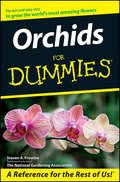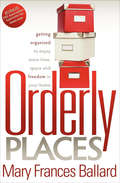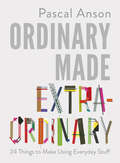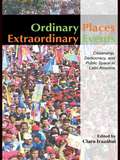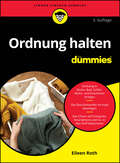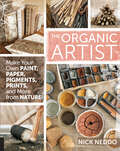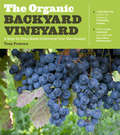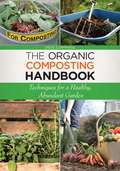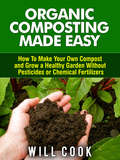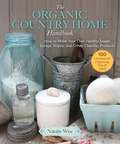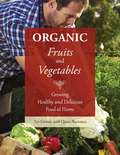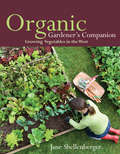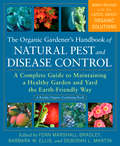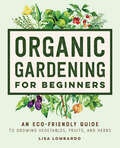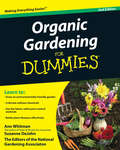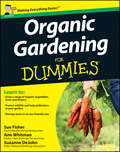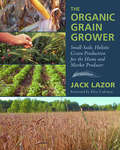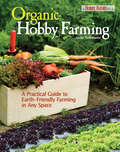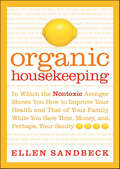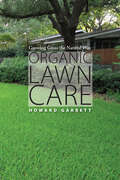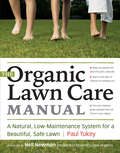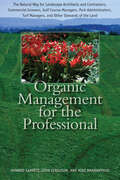- Table View
- List View
Orchids For Dummies
by National Gardening Association Steven A. FrowinePacked with photos, including 8 pages in full colorColor your world with orchidsOrchids are beautiful, fragrant, wonderfully varied, and surprisingly affordable. But aren't they hard to grow at home? No! says orchid grower extraordinaire Steve Frowine. In this handy guide, he shows you step by step how to select the right orchids, keep them healthy, encourage blooms, and even propagate your own plants.Discover how to:* Select orchids that will thrive in your home* Water, fertilize, repot, and propagate orchids * Decipher complicated orchid names* Get familiar with favorite orchid varieties* Create spectacular orchid displays
Orderly Places: Getting Organized to Enjoy More Time, Space and Freedom in Your Home
by Mary Frances BallardAre your mornings spent frantically looking for the misplaced keys or the field trip form? Do you have trouble deciding what to keep and what to let go? Are you too embarrassed by the way your house looks to invite family and friends in for a visit? Do you have stacks of things and no where to put them? Have you missed paying a bill on time because you could not find the monthly statement? Have you forgotten an appointment or to pick up a child from school or ball practice? Orderly Places offers you the strategies for when, where and how to overcome disorganization in your spaces and schedules. Practical step-by-step instructions and organizing tips are given for organizing every room in your home. Time management solutions are provided for schedules that are not efficient or effective. If you want to create a more peaceful, comfortable and organized environment or find more time in your day for the activities you love, then you are not alone. Learn how to get organized and be free to enjoy those things now.
Ordinary Made Extraordinary
by Pascal Anson'Filled with inexpensive and relatively easy do-it-yourself design projects for the home. Step-by-step photos show you how to do everything from dipping vintage cutlery in paint and reupholstering an armchair in shoelaces to covering a wall in mirrors' - Telegraph 'True original Pascal Anson urges us, with winning wit and idiot-proof step-by-steps to turn ''dad'' jeans, an ugly table, holey trainers, mismatched cutlery [...] into desirable stuff using the alchemy of imagination. His brief? Low skill levels and high concept' - World of Interiors In Ordinary Made Extraordinary designer, artist and maverick-maker Pascal Anson shows how easy it is to transform everyday items into extraordinary statement pieces. Make ordinary a thing of the past with 24 inspiring and achievable projects including: - Create a chandelier with just a few rolls of Sellotape. - Cast a stunning concrete plant pot. - Build a child’s treehouse with cling film.There are ideas for projects for everyone – from repairing and reinventing worn out trainers, to bigger projects such as the wood-clad car and the stylish hairy chair.
Ordinary Places/Extraordinary Events: Citizenship, Democracy and Public Space in Latin America (Planning, History and Environment Series)
by Clara IrazábalClara Irazábal and her contributors explore the urban history of some of Latin America’s great cities through studies of their public spaces and what has taken place there. The avenues and plazas of Mexico City, Havana, Santo Domingo, Caracas, Bogotaì, SaÞo Paulo, Lima, Santiago, and Buenos Aires have been the backdrop for extraordinary, history-making events. While some argue that public spaces are a prerequisite for the expression, representation and reinforcement of democracy, they can equally be used in the pursuit of totalitarianism. Indeed, public spaces, in both the past and present, have been the site for the contestation by ordinary people of various stances on democracy and citizenship. By exploring the use and meaning of public spaces in Latin American cities, this book sheds light on contemporary definitions of citizenship and democracy in the Americas.
Ordnung halten für Dummies (Für Dummies)
by Eileen RothDamit Tohuwabohu ein Fremdwort bleibt Haben Sie es satt, ewig Ihren Schlüssel zu suchen und ihn später im Kühlschrank wiederzufinden? Ordnung halten: Dem einen ist es einfach gegeben, die anderen müssen es mühsam lernen. Eileen Roth zeigt Ihnen, wie Sie Ihr Zuhause ordentlich halten und Ihren Arbeitsplatz effizient gestalten. Außerdem erfahren Sie, wie Sie Ihre Daten auf Computer, Smartphone und Co. ordnen und Ihren Urlaub so planen, dass Sie richtig entspannen. Wenn Sie gut organisiert sind, haben Sie weniger Arbeit, weniger Stress, mehr Freizeit und mehr Entspannung. Mithilfe dieses Buches finden Sie immer, was Sie suchen Sie erfahren Welche Hilfsmittel Ihnen beim Ordnen helfen Was Sie aufheben sollten und was nicht Welche grundlegenden Techniken es für das Zeitmanagement gibt Wie Sie das Chaos mit System beseitigen
The Organic Artist: Make Your Own Paint, Paper, Pigments, Prints, and More from Nature
by Nick NeddoDrawing on ancient techniques, a primitive-arts instructor shows how to reconnect with nature by making and using your own all-natural art supplies.The Organic Artist encourages you to return to those days when art was made with all-natural materials, like charcoal and birch bark. Immersing you in the natural world, this book seeks to inspire creativity by connecting you to your organic roots.In addition to offering a wide variety of suggestions for using nature as supplies for art, this book also introduces the concepts of awareness and perception that are foundational to the creative process. You can refine your drawing skills, as well as increase their appreciation for the visual arts and the natural landscape. Projects and skills covered include:Making paper and wild inkWorking with soapstone, clay, wood, and rawhidePrintmaking and stencilingNatural pigments and dyesCamouflage and body paintingNature journaling, and more“Clear, concise and easy to follow . . . a pleasure to both use as a how-to book and read through.” —Michael Pewtherer, author of Wilderness Survival Handbook
The Organic Backyard Vineyard: A Step-by-Step Guide to Growing Your Own Grapes
by Tom PowersInterest in wine shows no signs of slowing down—wine tours, tastings, and vacations are now common and homeowners often have space dedicated to their collection. The logical next step? Learning to grow and make your own.In The Organic Backyard Vineyard expert Tom Powers walks the small grower through the entire process of growing grapes, with a month-by-month maintenance guide covering all regions of the U.S. and Canada. He explains everything a beginning grape grower needs to know: how to design and build a vineyard, how to select grapes for each region, how to maximize yield using organic maintenance techniques, how to build a trellis, how to harvest at peak flavor, and how to store grapes for winemaking.This edition includes organic growing information and all new photography.
The Organic Composting Handbook: Techniques for a Healthy, Abundant Garden
by Dede CummingsGreat compost is one of the most important secrets of successful organic gardening. In this comprehensive guide, you'll learn everything you need to know about the various methods of composting and how to adapt them to your home and garden. With full-color photographs and easy-to-follow instructions, this will be a welcome addition to every organic gardener's library. Topics covered include: What you can and can't throw on your compost pile * How to balance nitrogen and carbon in your pile for quick decomposition and rich compost * Buying or building the best tools and containers * Vermicomposting * How to compost indoors * Troubleshooting smelly compost, dry compost, and other problems * How and when to apply the compost to your garden beds. With growing concerns about the use of pesticides, herbicides, and GMOs in mainstream gardening practices, more and more families are turning to their backyards to grow their own food using methods they know are safe. The need for clear, straightforward instruction on organic gardening techniques has never been greater. With The Organic Composting Handbook, readers will get the information they need to prepare their gardens for healthy, abundant crops.
Organic Composting Made Easy: How to Make Your Own Compost and Grow a Healthy Garden Without Pesticides or Chemical Fertilizers
by Will CookEnrich your garden with this simple, practical guide to the composting process.Whether you have a tiny yard or a lot of space, you can grow delicious, healthy, organic vegetables and foods for you and your family—and composting is a key part of the process. A natural fertilizer and soil enhancer, compost can be bought in a store—but even better, you can create it yourself, making use of organic waste from your own home and kitchen instead of tossing it in the trash. This not only saves you money—it helps save the environment. With this informative book you’ll learn about:The benefits of composting for your garden and the earthHow the composting process worksTips and hints for easy compostingUnexpected approaches to organic composting, and more
The Organic Country Home Handbook: How to Make Your Own Healthy Soaps, Sprays, Wipes, and Other Cleaning Products
by Natalie WiseA Beautiful and Modern Handbook for Keeping Home the Natural WayHome is a haven, a place of refuge. But did you know it might be making you sick? If your home is cluttered, overwhelming, and full of chemicals, it’s time to detox. The Organic Country Home helps you declutter and clean with natural, homemade products that are healthy for you and your family. You’ll find information on why you should start going organic now and the best organic cleaning products and supplies, where to find them, and how to make them. Start with the basics and work your way into every corner of your home . . . from tile grout to shower mold, how to clean lampshades to how to clean water bottles. There are recipes for cleaning nearly every surface in your home from the carpet to stuffed animals. If you have questions about keeping an organic home, The Organic Country Home has answers. You’ll also learn storage and organization secrets to keep your home clutter-free, how to manage your time and budget, and why some old-fashioned remedies are still the modern organic ways to keep home. Not only will you find your home cleaner and fresher than ever, it will be inviting, welcoming, and an altogether modern organic home. Now is the time to get started.
Organic Fruits and Vegetables: Growing Healthy and Delicious Food at Home
by Teo Gomez Quico BarrancoThis book offers a clear picture of all that we need to know to make our small plot of land the most productive it can be. The authors present the information in a way that is cognizant to the people, plants, insects, and animals that live on the land. Thus, they do not recommend the use of pesticides or fertilizers or any other product that can be poisonous or unnatural. They choose organic seeds to maintain practices that promote, rather than destroy, the environment. This book contains, among other themes: * Horticultural techniques, from irrigation practices to sowing, tending, and harvesting * 1,001 ways to get rid of creatures that plague us, without exterminating them * All the plants we can grow and how to do so in the best way possible * Fruit trees, aromatic plants, and plants you can eat * Plants you should avoid * And much more!
Organic Gardener's Companion: Growing Vegetables in the West
by Jane ShellenbergerLifelong gardener Jane Shellenberger brings us this comprehensive, hands-on guide to growing organic produce in the Rocky Mountain and western region, including Colorado, parts of New Mexico, Arizona, Utah, Wyoming, Montana, Idaho, and eastern Oregon. The text covers soil cultivation, plant selection, water, microclimates, and other concerns specific to semiarid and high-altitude climates. Color photographs enhance this easy-to-use and accessible gardening guide.Jane Shellenberger is an eclectic gardener and environmental activist. She is publisher and editor of the regional gardening magazine Colorado Gardener, a thinking gardener's companion, which she founded in 1997. She is also a member of the Garden Writers Association. Shellenberger lives on a five-acre farmette on the plains between Boulder and Longmont, Colorado.
The Organic Gardener's Handbook of Natural Pest and Disease Control: A Complete Guide to Maintaining a Healthy Garden and Yard the Earth-Friendly Way (Rodale Organic Gardening)
by Fern Marshall Bradley Barbara W. Ellis Deborah L. MartinWith growing consumer awareness about the dangers of garden chemicals, turn to The Organic Gardener's Handbook of Natural Pest and Disease Control as the most reliable and comprehensive guide on the garden shelf. Rodale has been the category leader in organic methods for decades, and this thoroughly updated edition features the latest science-based recommendations for battling garden problems. With all-new photos of common and recently introduced pests and plant diseases, you can quickly identify whether you've discovered garden friend or foe and what action, if any, you should take.No other reference includes a wider range of methods for growing and maintaining an organic garden. The plant-by-plant guide features symptoms and solutions for 200 popular plants, including flowers, vegetables, trees, shrubs, and fruits. The insect-and-disease encyclopedia includes a photo identification guide and detailed descriptions of damage readers may see. The extensive coverage of the most up-to-date organic control techniques and products, presented in order of lowest impact to most intensive intervention, makes it easy to choose the best control.
Organic Gardening for Beginners: An Eco-Friendly Guide to Growing Vegetables, Fruits, and Herbs
by Lisa LombardoThe ultimate starter guide to a naturally healthy home garden Imagine cooking with organic tomatoes right off the vine or seasoning with fresh, homegrown herbs. Organic Gardening for Beginners shows aspiring home gardeners how to get started. Learn to raise dozens of fruits and veggies at home with sustainable and eco-friendly practices that protect the environment and produce safe, nutritious food—no grocery store required. Discover what it means to keep a completely organic garden with tips, advice, and step-by-step instructions for planting the right plants at the right time, designing an efficient layout, and attracting the right pollinators to help every garden thrive. Dig into organic gardening: Getting started—Begin with an overview of the most popular types of organic gardening—from in-ground to containers—and decide which one works best in every space. Natural growth methods—Find out how to choose soil, control pests with no chemicals, and combine the crops that grow well together. Plant profiles—Get an explanation of each crop that breaks down what it needs to grow and what beginners need to know for success. Grow your own thriving backyard ecosystem with expert advice on nourishing organic gardening.
Organic Gardening For Dummies
by Suzanne Dejohn Ann Whitman The National Gardening AssociationOrganic Gardening For Dummies, 2nd Edition shows readers the way to ensure a healthy harvest from their environmentally friendly garden. It covers information on the newest and safest natural fertilizers and pest control methods, composting, cultivation without chemicals, and how to battle plant diseases. It also has information on updated equipment and resources. It helps readers plant organically year-round, using herbs, fruits, vegetables, lawn care, trees and shrubs, and flowers. The tips and techniques included in Organic Gardening For Dummies, 2nd Edition are intended to reduce a garden's impact on both the environment and the wallet.
Organic Gardening for Dummies, UK Edition
by Sue FisherReduce a garden's impact on both the environment and the walletOrganic Gardening For Dummies shows readers the way to ensure a healthy harvest from an environmentally friendly garden. It covers information on the newest and safest natural fertilizers and pest control methods, composting, cultivation without chemicals, and how to battle plant diseases. It also has information on updated equipment and resources. It helps the reader to plant organically year-round, using herbs, fruits, vegetables, lawn care, trees and shrubs, and flowers.Organic Gardening For Dummies show readers how to:Plan out the perfect organic gardenProtect wildlife and help pollinators in a gardenGrow a range of organic vegetables, fruits and flowersManage pests in an eco-friendly way
Organic Gardening without Poisons
by Hamilton TylerThis book explains how to restore health to the home garden by returning to natural gardening methods. Nature can benefit the gardener if he does not interfere with its complicated and delicate balance by using synthetic insecticides and fertilizers.
The Organic Grain Grower
by Jack LazorThe ultimate guide to growing organic grains on a small and ecological scale, The Organic Grain Grower is invaluable for both home-scale and commercial producers interested in expanding their resiliency and crop diversity through growing their own grains. Longtime farmer and organic pioneer Jack Lazor covers how to grow and store wheat, barley, oats, corn, dry beans, soybeans, pulse crops, oilseeds, grasses, nutrient-dense forages, and lesser-known cereals. In addition to detailed cultivation and processing information, Lazor argues the importance of integrating grains on the organic farm (not to mention for the local-food system) for reasons of biodiversity and whole farm management. Including extensive information on: The history of grain growing and consumption in North America The twenty-first century and the birth of the local-food movement Considering your farm's scale and climate Understanding soil fertility and structure Planting your crop (including spring vs. fall cereals and preparing your soil) The growing and ripening process (reproductive, milk, hard-and-soft dough stages) The grain harvest Preparing grain for sale, storage, or end use (drying, cleaning seed, grain handling) Seed breeding and saving Machinery, infrastructure, and processing (both home-scale tools and larger farm equipment) Grinding grains for livestock rations (including how to put together a ration based on protein content) and sample rations for dairy cows, pigs, and chickens Processing grains for human consumption Additional resources and information for new grain farmers, and more. . . Beginners will learn how to grow enough wheat for a year's supply of bread flour for their homestead, and farmers will learn how to become part of a grain co-op, working alongside artisan bakers and mills. Never before has there been a guide to growing organic grains applicable both for the home-scale and professional farming scale. This will be a classic for decades to come and a crucial addition to any farmer's, homesteader's, gardener's, agronomist's, or seed-saver's library.
Organic Hobby Farming
by Andy TomolonisIn Organic Hobby Farming, Andy Tomolonis, a longtime organic gardener, part-time hobby farmer, and award-winning Boston-area journalist, strips down the concept of "organic" and explains why natural farming has emerged as the healthiest and most viable method of growing for hobby farms and other small-scale operations. In addition to the improved taste and the appeal of excluding toxic materials, organic farming benefits farmers, their families, and the environment. It offers economic plusses as well. The current consumer demand for "local" and "organic" food underscores the need for small hobby farms that offer unique high-end goods. Tomolonis explains the basic principles of organic farming and describes how hobby farmers and their families can eat healthier, save money, help preserve the environment, and even turn their passion into a small-scale side business.Chapter 1 will help you assess the land you live on to determine whether it's suited for organic vegetables, fruit, berries, or livestock. Farmers who are looking to lease or buy land will find practical advice on how to evaluate properties and find their best use, taking climate, soil, water and geography into consideration. In Chapter 2, Tomolonis continues with practical advice on how to choose the right tools without overspending-starting slowly with quality hand implements and then expanding as you determine the need for costlier power equipment.Chapter 3 moves on to the heart of any successful organic farm-building the soil. "The Good Earth" brings readers down to earth, i.e., the soil. You'll learn how to evaluate and improve your soil with compost and cover crops and protect it from erosion, chemical contamination and other harm. The author also stresses the importance of understanding the complex relationship between underground soil organisms that play such a crucial role in natural plant health. The best soil, with the right balance of nutrients and a healthy population of microbes, will help your plants survive hardship, resist diseases and produce healthier more bountiful harvests, the author explains.Chapter 4 walks you through the steps needed to develop an organized farm plan. The chapter presents a convenient month-by-month overview of the farmer's year, offering a timeline and detailed instructions for sowing seeds indoors, transplanting seedlings, guarding against insects and weeds, harvesting, planting cover crops extending the season and developing a schedule for successive food crops. Whether you want to feed your growing family all summer long or produce enough food for a small-scale agribusiness, the information here is invaluable. This chapter also covers organic methods for harnessing the power of nature by luring beneficial insects that will help control farm and garden pests.Learn about heirlooms, hybrids, and eclectic vegetable varieties in the comprehensive directory of vegetable crops and herbs introduced in Chapter 5. Tomolonis reveals his favorite varieties, including many alluring heirlooms that have grown in popularity. Each crop description offers detailed information on soil preparation, sowing, companion planting, and battling weeds and insects without harmful chemicals. The author, a former produce manager for a national grocery chain, also includes tips for harvesting crops, prepping them for display, and bringing the goods to market.If you're looking for advice on fruits and berries, Organic Hobby Farms introduces new options in Chapter 6, where the author suggests ways to branch out with Asian pears, peaches, and apples, as well as nutritious blueberries, blackberries, raspberries and strawberries. As he does in other chapters, Tomolonis explains in common terms, how to choose the best varieties for your region, prepare the soil for maximum production, and deal with pests and diseases organically.Organic Hobby Farming also describes the basics of adding chickens to your farm-for wholesome organic eggs or pastured meat. Select the right breeds, raise a flock from day-old chicks and protect the birds from predators and ...
Organic Housekeeping: In Which the Nontoxic Avenger Shows You How to Improve Your Health and That of Your Family While You Save Time, Money, and, Perhaps, Your Sanity
by Ellen SandbeckLonging for a kinder, gentler world? As the old saying goes, everything begins at home, and odds are, if you live in the all-American household, the air inside is more toxic than the air outside, even if you live in the most polluted of cities. You regularly handle the filthiest object in your home -- the kitchen sponge -- and put the same chemicals on your face that are used in brake fluid and antifreeze. The cleaning agents and personal care products commonly marketed to and used in American homes contain not only some very dangerous, toxic chemicals, but they also create an "overly clean," chemically bombed-out house that compromises immune systems. And with more than fifty million Americans suffering from allergies and other autoimmune diseases -- not to mention the developing and fragile immune systems of children and seniors -- large numbers of people are actually being made sicker and sicker by their homes. Learn to live a clean, healthy, more economical way with Ellen Sandbeck, the nontoxic avenger. In this must-have book for the twenty-first- century home, this passionate, witty advocate of all things organic will teach you how to maintain every part of the home -- from living room to septic tank, kitchen floor to bathroom sink -- using safe, simple cleansers and quick preventative measures as well as the most effective organic products on the market to get the job done. Learn time-saving, preventative housekeeping, such as taking thirty seconds to clean the shower while you shower. Take care of bathroom stains with baking soda and vinegar rather than commercial, toxic bathroom "bombs" peddled to you with such force by manufacturers. Need whiter whites? There is no bleaching power on earth stronger than the sun. Snow clean your fine rugs. Choose fruits and vegetables from the relatively pesticide residue-free list. Clean felt-tipped pen stains with vodka. Make furniture shine with olive oil and lemon. Your house will also smell as great as it looks.
Organic Lawn Care: Growing Grass the Natural Way
by Howard GarrettA renowned landscape gardener&’s guide to less expensive, less water-intensive lawns, whether it&’s a front yard or a fairway.A lush green lawn is one of the great pleasures of the natural world, whether it&’s outside your front door or on a majestic fairway at a legendary golf course. But anyone who&’s tried to grow the perfect lawn the conventional way knows it requires an endless cycle of watering and applying synthetic fertilizers and toxic chemical pesticides that costs a lot of money and kills all the life in the soil, on the surface, and on the grass. Fortunately, there&’s a better way. Organic lawn care is not only healthier for the environment, it&’s actually cheaper and less water-intensive, whether you&’re managing a small yard or acres of turf. In this book, Howard Garrett, the renowned &“Dirt Doctor,&” takes you step-by-step through creating and maintaining turf organically. He begins with the soil, showing you how to establish a healthy habitat for grass. Then he discusses a variety of turfgrasses, including Bermudagrass, bluegrass, buffalo grass, fescue, ryegrass, St. Augustine, and zoysia. He explains in detail planting, mowing, watering, fertilizing, composting, and managing weeds and pests. And he offers alternatives to lawn grasses and turf, describing the situations in which they might be your best choice.
Organic Lawn Care: Growing Grass the Natural Way
by Howard GarrettA renowned landscape gardener&’s guide to less expensive, less water-intensive lawns, whether it&’s a front yard or a fairway.A lush green lawn is one of the great pleasures of the natural world, whether it&’s outside your front door or on a majestic fairway at a legendary golf course. But anyone who&’s tried to grow the perfect lawn the conventional way knows it requires an endless cycle of watering and applying synthetic fertilizers and toxic chemical pesticides that costs a lot of money and kills all the life in the soil, on the surface, and on the grass. Fortunately, there&’s a better way. Organic lawn care is not only healthier for the environment, it&’s actually cheaper and less water-intensive, whether you&’re managing a small yard or acres of turf. In this book, Howard Garrett, the renowned &“Dirt Doctor,&” takes you step-by-step through creating and maintaining turf organically. He begins with the soil, showing you how to establish a healthy habitat for grass. Then he discusses a variety of turfgrasses, including Bermudagrass, bluegrass, buffalo grass, fescue, ryegrass, St. Augustine, and zoysia. He explains in detail planting, mowing, watering, fertilizing, composting, and managing weeds and pests. And he offers alternatives to lawn grasses and turf, describing the situations in which they might be your best choice.
The Organic Lawn Care Manual: A Natural, Low-Maintenance System for a Beautiful, Safe Lawn
by Paul TukeyCreate a gorgeous lawn that is free of harsh chemicals. This comprehensive guide covers everything you need to know to grow and maintain a thriving lawn using organic gardening methods. With expert advice on planting the best grass varieties, nourishing the soil, watering, fighting weeds, and sustainable maintenance, Paul Tukey helps you create a luscious and inviting lawn that is pesticide-free and safe for your children and pets.
Organic Management for the Professional: The Natural Way for Landscape Architects and Contractors, Commercial Growers, Golf Course Managers, Park Administrators, Turf Managers, and Other Stewards of the Land
by Howard Garrett Ferguson John Mike AmaranthusCan you manage the landscape of a golf course, city park, or corporate campus without synthetic fertilizers and toxic pesticides? Absolutely! Organic landscaping is not only possible on a large scale, but it also makes sense both economically andNationally acclaimed organic gardening expert Howard Garrett offers detailed, proven instructions for designing and managing large-scale landscapes organically. environmentally. It promotes healthy soils and plants, which require less water and sequester more carbon-a winning combination for both your bottom line and the planet's fight against resource depletion and global warming. Organic programs on a commercial scale have enormous potential to make a difference in the quality of our environment, our use of fuels, and our climate. And as those who have already converted to organics have discovered, they also cost a lot less over the long term. Organic Management for the Professional is the first comprehensive guide to "going green" in large-scale landscaping. Nationally recognized organic gardening expert Howard Garrett, with associates John Ferguson and Mike Amaranthus, not only explains in detail how to manage projects with natural organic techniques, but also presents the material in clear, simple terms so that commercial and institutional property owners can understand what to ask of their landscape architects, contractors, growers, and maintenance people. They give detailed, proven instructions for the key components of organic landscaping-soil building, correct planting techniques, fertilizing, pest control, compost, and mulch. Then they show how to apply these organic methods in large-scale landscaping, commercial growing (orchards, tree farms, nurseries, and greenhouse operations), and recreational properties (golf courses, parks, and sports fields).
